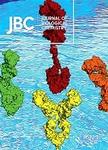版权所有:内蒙古大学图书馆 技术提供:维普资讯• 智图
内蒙古自治区呼和浩特市赛罕区大学西街235号 邮编: 010021

作者机构:Hebrew Univ Jerusalem Alexander Silberman Inst Life Sci Dept Biol Chem IL-91904 Jerusalem Israel Hebrew Univ Jerusalem Alexander Silberman Inst Life Sci Otto Loewi Ctr Mol & Cellular Neurobiol IL-91904 Jerusalem Israel
出 版 物:《JOURNAL OF BIOLOGICAL CHEMISTRY》 (生物化学杂志)
年 卷 期:1999年第274卷第41期
页 面:29519-29528页
核心收录:
学科分类:0710[理学-生物学] 071010[理学-生物化学与分子生物学] 07[理学]
主 题:乙酰胆碱/代谢 结合 竞争性 脑/代谢 CHO细胞 钙/代谢 卡巴胆碱/代谢 仓鼠亚科 胞吐作用 膜电位 膜蛋白质类/代谢 毒蕈碱激动剂/药理学 毒蕈碱拮抗剂/药理学 N-甲基东莨菪碱/代谢 蛋白质结合 Qa-SNARE蛋白质类 受体 毒蕈碱/分类 受体 毒蕈碱/代谢 突触体/代谢 转染 动物 人类 大鼠
摘 要:Membrane depolarization is the signal that triggers release of neurotransmitter from nerve terminals. As a result of depolarization, voltage-dependent Ca2+ channels open, level of intracellular Ca2+ increases. and release of neurotransmitter commences. Previous study had shown that in rat brain synaptosomes, muscarinic acetylcholine (ACh) receptors (mAChRs) interact with soluble NSF attachment protein receptor proteins of the exocytic machinery in a voltage-dependent manner. It was suggested that this interaction might control the rapid, synchronous release of acetylcholine, The present study investigates the mechanism for such a voltage-dependent interaction. Here we show that depolarization shifts mAChRs, specifically the m2 receptor subtype, to a low affinity state toward its agonists, At resting potential, mAChRs are in a high affinity state (K-d of similar to 20 nM) and they shift to a low affinity state (K-d of tens of mu M) upon membrane depolarization. In addition, interaction between m2 receptor subtype and the exocytic machinery increases with receptor occupancy. Both phenomena are independent of Ca2+ influx. We propose that these results may explain control of ACh release from nerve terminals. At resting potential the exocytic machinery is clamped due to its interaction with the occupied mAChR and depolarization relieves this interaction. This, together with Ca2+ influx, enables release of ACh to commence.